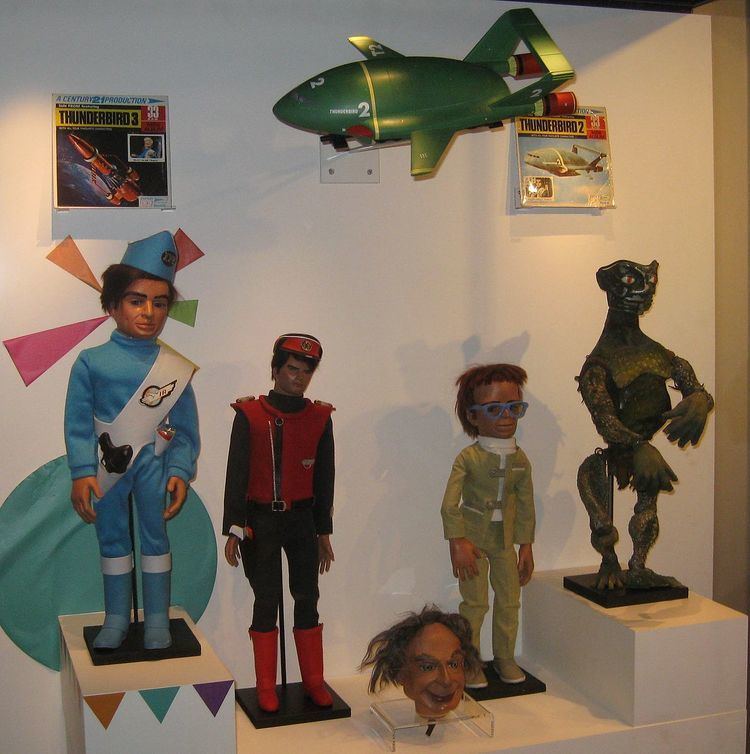 | ||
Supermarionation (a portmanteau of "super", "marionette" and "animation") is a puppetry technique devised in the 1960s by British production company AP Films. It was used extensively in the company's numerous Gerry and Sylvia Anderson-produced action-adventure series, the most famous of which was Thunderbirds. The term was coined by Gerry Anderson.
Contents
Development and use in Gerry Anderson productions
The system used marionettes suspended and controlled by thin wires. The fine metal filaments were both suspension-control wires for puppet movement, and electric cables that provided control signals to the electronic components in the marionettes' heads. Although efforts were made to minimise this, the strings controlling the puppets are often visible, although the production teams' ability to mask the strings and the fineness of the strings noticeably improved through the various series.
The heads contained solenoids that created the facial movements for dialogue and other functions. The voice synchronisation was achieved with a specially designed audio filter, actuated by the signal from the pre-recorded tapes of the voice actors. This filter converted the signal into a series of pulses that travelled to the solenoids controlling the puppet's lips. Up to and including Thunderbirds, these control mechanisms were placed inside the puppets' heads. This required that the heads be disproportionately large compared to the bodies. The rest of the body could not be increased to match, lest the puppet be too bulky to operate.
With the advent of miniaturised electronic components in the mid-1960s, a new type of puppet was designed with control mechanisms in the chest, connected to the mouth by narrow rods through the neck. This resulted in a far more proportionate appearance for the puppets, first appearing in Captain Scarlet and the Mysterons. In a 2002 interview, Anderson revealed that it was his desire to move into live-action television during the production of Captain Scarlet and the Mysterons, and that he endorsed the new, realistic design of the Supermarionation puppets as a compromise for his inability to use live actors.
Because the marionettes could not walk convincingly, most scenes depicted the characters either standing or sitting, or placed them in settings that allowed the use of vehicles and other mechanical transportation systems. The personal hovercraft used in Fireball XL5 and Thunderbirds were one of the devices the producers used to overcome this.
Occasionally, close-ups of a live actor's hand would be inserted to show actions such as turning keys and pressing buttons. This was affectionately parodied in the 2004 live-action feature film Thunderbirds, with a brief shot of a puppet hand, suspended by wires, operating the controls of Thunderbird 1.
In many cases, the puppets were modelled on the actor voicing the role. Two examples are Lady Penelope in Thunderbirds, which closely resembled Sylvia Anderson, and Captain Blue in Captain Scarlet, who looks like his voice actor Ed Bishop (the similarity was reportedly coincidental). Other characters were based on well-known film stars, such as Captain Troy Tempest in Stingray, who was based on James Garner, Scott Tracy in Thunderbirds, who was modelled on Sean Connery, and Captain Scarlet in Captain Scarlet and the Mysterons, whose voice and appearance were modeled on Cary Grant. Stingray also featured the only non-speaking Supermarionation puppet: the water-breathing woman Marina.
Anderson's "Supermarionated" television shows
The term "Supermarionation" was not coined until during production of later episodes of Supercar. As a result, Four Feather Falls is often omitted from lists of Supermarionation productions.
The Secret Service was actually a hybrid of live action and Supermarionation, using footage of live actors from a distance to depict driving, walking, etc. Production was cancelled by ITC owner Lew Grade before the pilot episode aired; the 13 completed episodes aired sporadically on ATV and other British broadcasters beginning in 1969. Despite the poor reception, Anderson has been quoted as naming The Secret Service as his favorite Supermarionation series.
In 1973, Anderson produced a pilot episode for another Supermarionation/live-action hybrid entitled The Investigator but was displeased with the results, so no series resulted. This is the last known occasion in which a full Supermarionation production was mounted.
Two feature films based upon Thunderbirds were also made with Supermarionation: Thunderbirds Are Go (1966) and Thunderbird 6 (1967). Numerous episodes of Thunderbirds, Captain Scarlet, and other series were also edited together (sometimes with the addition of new narration) to form movie-length features for VHS release and TV syndication in the 1980s.
In 1991, Anderson produced Supermarionation versions of the Dire Straits band members for the music video "Calling Elvis".
Supermarionation techniques were recreated and employed during the production of Filmed in Supermarionation, a 2014 documentary that told the behind the scenes story of the films and television series produced by AP Films.
Supermacromation
In the early 1980s, Anderson returned to puppetry for the science fiction series Terrahawks. In this show the characters were realised using hand-controlled puppets, mostly controlled from beneath using a system called Supermacromation, which was broadly similar to the techniques developed by Jim Henson.
Hypermarionation
In 2004, Gerry Anderson produced Gerry Anderson's New Captain Scarlet, which was rendered using computer-generated imagery (CGI) and motion-capture techniques. As a nod to Supermarionation, the show is promoted as being produced in Hypermarionation.
